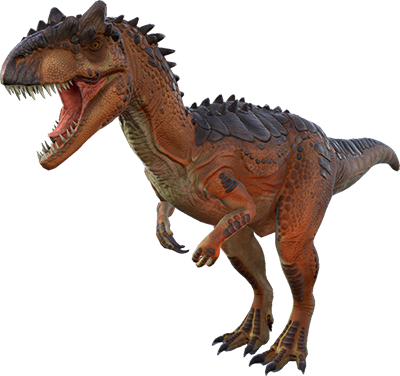 Dododex
ARK: Survival Evolved & Ascended Companion
Dododex
ARK: Survival Evolved & Ascended Companion
Tips & Strategies

Allosaurus was a large bipedal predator for its time. Its skull was light, robust, and equipped with dozens of sharp, serrated teeth. It averaged 8.5 meters (28 ft) in length for A. fragilis, with the largest specimens estimated as being 9.7 metres (32 ft) long. Relative to the large and powerful legs, its three-fingered hands were small and the body was balanced by a long, muscular tail. It is classified as an allosaurid, a type of carnosaurian theropod dinosaur.
The genus has a very complicated taxonomy and includes at least three valid species, the best known of which is A. fragilis. The bulk of Allosaurus remains have come from North America's Morrison Formation, with material also known from Portugal. It was known for over half of the 20th century as Antrodemus, but a study of the abundant remains from the Cleveland-Lloyd Dinosaur Quarry returned the name "Allosaurus" to prominence and established it as one of the best-known dinosaurs.
As the most abundant large predator of the Morrison Formation, Allosaurus was at the top of the food chain and probably preyed on contemporaneous large herbivorous dinosaurs, with the possibility of hunting other predators. Potential prey included ornithopods, stegosaurids, and sauropods. Some paleontologists interpret Allosaurus as having had cooperative social behavior and hunting in packs, while others believe individuals may have been aggressive toward each other and that congregations of this genus are the result of lone individuals feeding on the same carcasses. -Noodle913
More Allosaurus Everything Else Tips
Taming isn’t the problem getting one alone is the real challenge am I right
Are they on ark mobile cuz I never see one like if this is on mobile
Cool guy. You get me? Hahah....
Allos are great mounts for ground and the highest lvl just like direwolf a has an orange thing i prefer killing the highest lvls and tame the lowest in a pack and then take an high lvl in the other gender and breed them that way I get an good killer
Who else here found ark by playing the mobile version then swithing to PC/Console and geting addicted?
If your base is in griff mountain make sure you always check outside as there is like 3 groups of 3 most times
Friends, this dinosaur is perfect for collecting chitin. For example, I can extract as many as 32 chitin from one scorpion . I don't understand why others think that allosaurus is bad.
Carno isn’t much better than this guy in speed because they both have the shitty stamina regeneration am i right?
When alone, they’re ok. They have bad stamina but they are easy tames for the mid game. However, they are unstoppable if you get a group of them, which is quite easy since they aren’t usually found alone. I have five of these bad boys and they tear through everything. They’ve became my overall favourite dinosaur because of my pack. On their own, they are ok but replaceable, but nothing beats a pack